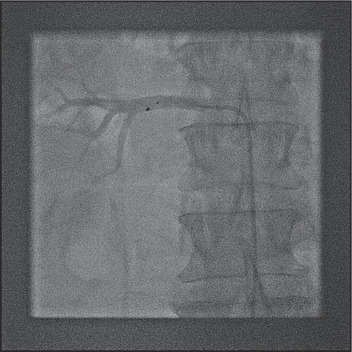A 58‐year‐old morbidly obese man presented for preoperative evaluation prior to bariatric surgery. He had a long‐standing history of diabetes mellitus and hypertension. His current body weight was 125 kg (body mass index, 42 kg/m2). Systolic blood pressure (SBP) measurements over a period of 6 months during clinical visits ranged from 150 mm Hg to 180 mm Hg, necessitating frequent uptitration of medications. His antihypertensive regimen included a thiazide diuretic, β‐blocker, calcium channel blocker, and angiotensin II receptor blocker, which were near maximal doses. His creatinine clearance was >45 mL/m2, and Doppler ultrasound of renal arteries revealed no renal artery stenosis. Echocardiography showed normal left ventricular function with mild left ventricular hypertrophy. Myocardial perfusion scan was negative for ischemia. He was deemed fit for the intermediate‐risk surgery except for his elevated SBP, which was of concern to the operating team and anesthesiologist. Based on his clinical profile, he fulfilled the diagnostic criteria for resistant hypertension and was offered percutaneous renal denervation therapy (RDT). He underwent percutaneous RDT (Figure) under local anesthesia with 5 radiofrequency ablations performed to both renal arteries.
Figure FIGURE.

Renal angiography showing the Symplicity catheter system (Medtronic, Mountain View, CA) delivering radiofrequency ablation to right renal artery.
A marked improvement of SBP (range, 125 to 140 mm Hg) was observed during weekly clinical visits post‐discharge. He underwent the gastric bypass surgery 4 weeks later and the operation was uneventful. Blood pressure (BP) recording showed a much better controlled profile (range, 110 mm Hg to 130 mm Hg) during the perioperative period.
Our index patient presented with two challenging problems, ie, hypertension, which was difficult to control, and the need for bariatric surgery. Hypertension is a major risk factor for stroke, coronary artery disease, left ventricular hypertrophy, and heart failure. About 5% to 15% of hypertensive patients are estimated to have resistant hypertension, defined 1 as uncontrolled BP despite the use of at least 3 antihypertensive drugs of different classes, one of which should be a diuretic. Patients with resistant hypertension are more likely to have target organ damage and are at greater risk for cardiovascular complications. These complications may occur during stressful situations, such as surgery, since pre‐existing hypertension can induce a variety of cardiovascular responses that potentially increase the risk of surgery. The level of risk is dependent on the severity of hypertension. The ideal circumstance is to normalize BP for several months prior to elective surgery. Current therapeutic strategies 1 , 2 for hypertension are based mainly on lifestyle interventions and pharmacologic therapies. The latter has significant limitations, including limited efficacy, compliance issues, cost issues, and adverse effects. There is a compelling need for additional therapeutic approaches.
Percutaneous RDT using a novel catheter‐based renal nerve ablation procedure represents a new strategy in dealing with resistant hypertension. This novel therapy targets the well‐established role of heightened sympathetic nervous system activity in the development of hypertension and uses modern interventional techniques to disrupt the system in a selective and localized manner at the level of the kidney. Preliminary data from several studies 3 , 4 , 5 have been promising as office BP was significantly reduced at 12 months and this reduction was sustained up to 24 months of follow‐up. Because of the favorable clinical data and lack of other viable options, we decided to treat our index patient with percutaneous RDT, and his BP profile responded favorably. We were able to reduce his perioperative risk and he underwent the bariatric surgery uneventfully. To our knowledge, this is the first reported case of successful application of percutaneous RDT to treat resistant hypertension as a preoperative strategy before a moderate‐risk noncardiac surgery. Although we have shown this approach to be feasible, our initial observation still needs to be confirmed in further studies.
Disclosures: The authors report no conflict of interest.
References
- 1. Calhoun DA, Jones D, Textor S, et al. Resistant hypertension: diagnosis, evaluation, and treatment. A scientific statement from the American Heart Association Professional Education Committee of the Council for High Blood Pressure Research. Hypertension. 2008;51:1403–1419. [DOI] [PubMed] [Google Scholar]
- 2. Sarafidis PA, Bakris GL. Resistant hypertension: an overview on evaluation and treatment. J Am Coll Cardiol. 2008;52:1749–1757. [DOI] [PubMed] [Google Scholar]
- 3. Krum H, Schlaich M, Whitbourn R, et al. Catheter‐based renal sympathetic denervation for resistant hypertension: a multicentre safety and proof‐of‐principle cohort study. Lancet. 2009;373:1275–1281. [DOI] [PubMed] [Google Scholar]
- 4. Symplicity HTN‐1 Investigators . Catheter based renal sympathetic denervation for resistant hypertension: durability of blood pressure reduction out to 24 months. Hypertension. 2011;57:911–17. [DOI] [PubMed] [Google Scholar]
- 5. Symplicity HTN‐2 Investigators . Renal sympathetic denervation in patients with treatment‐resistant hypertension (The Symplicity HTN‐2 Trial): a randomized controlled trial. Lancet. 2010;376:1903–1909. [DOI] [PubMed] [Google Scholar]


